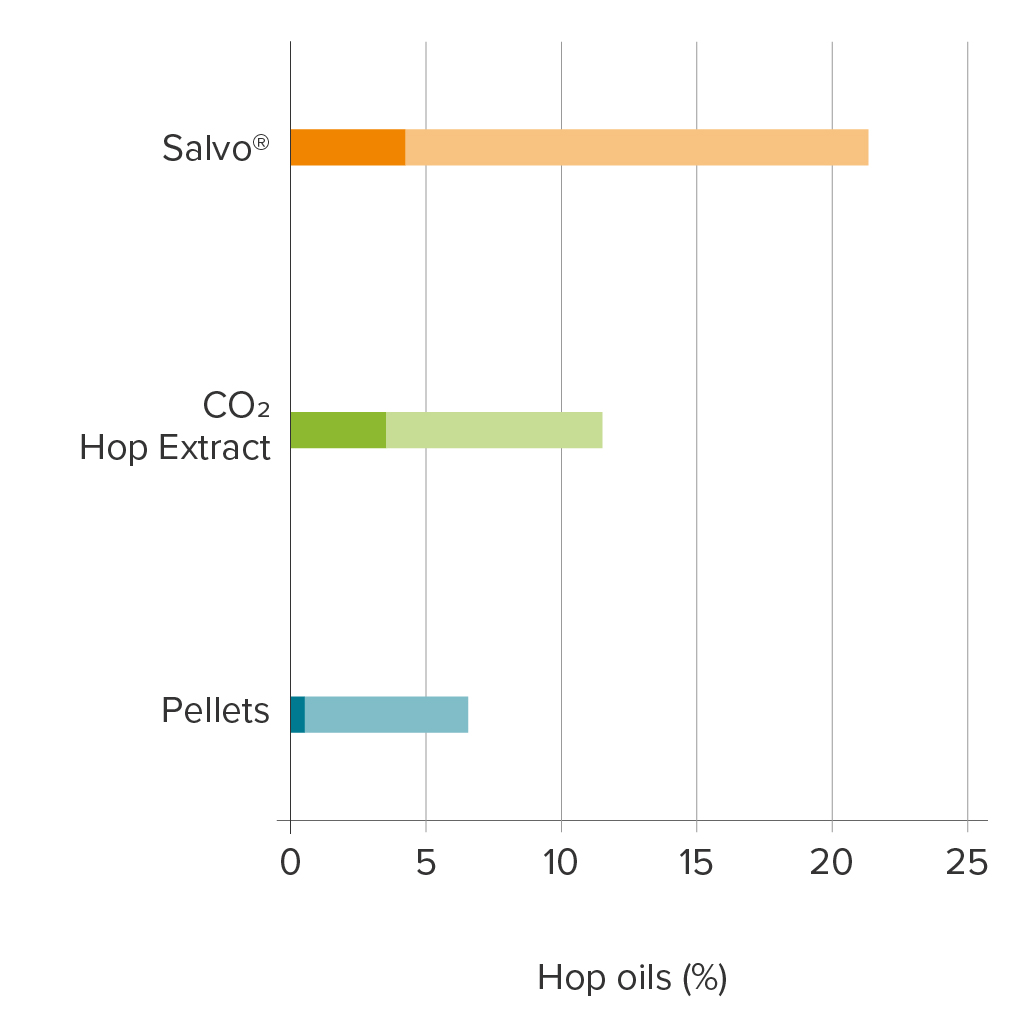
Salvo
Overview
Salvo is derived from CO2 hop extract and contains primarily hop essential oils and beta acids.
Salvo is added late in the boil to impart a distinct variety specific hop aroma to beer. If added early to the wort kettle, it can be used as an antifoam agent.
Salvo can help to suppress microbial infections due to the presence of beta acids.
Salvo has little to no sensorial bitterness.

Specifications
- Short description
- single-variety hop extract with a high content of hop essential oils and beta acids
- Iso-alpha and alpha acids
- < 4 %
- Beta acids
- 24 - 55 %
- Hop oils
- 4 - 22 %
- pH
- 7.5 ± 0.5
- Density
- ca. 1.0 g / ml (20 °C / 68 °F)
- Viscosity
- 30 - 100 mPas (50 °C / 122 °F)
Properties
Appearance
Salvo is a yellow-brown, semisolid or moderately viscous paste.
Flavor
Salvo provides kettle hop character when added during wort boiling. Late kettle additions impart a typical “late hop” aroma to the finished beer. The flavor depends on the variety, quantity and time of addition. For further information, please refer to the hop variety data sheets. Small quantities of residual iso-alpha and alpha acids will hardly contribute to beer bitterness.
Utilization
The utilization will vary from brewery to brewery due to differences in equipment and process conditions, such as dosing point.
Quality
All Hopsteiner® products are processed in facilities which fulfill internationally recognized quality standards.
Packaging
Our products are delivered in their respective recommended standard packaging. Alternatives may be possible upon customer request.
Standard packages of our processing plants in the USA (US) and Germany (DE) are:
- Cans 0.5 - 4.0 kg (US)
- Cans 0.5 - 3.1 kg (DE)
- Pail 4 - 20 kg (US)
- Drum 200 kg (US / DE)
Usage
Salvo is typically added to the kettle to achieve a characteristic hop aroma. An early addition aids in suppressing foam formation at the beginning of wort boiling. Good recovery of aroma substances can be achieved when added late to the boil or into the whirlpool.
Dosage
Actual dosage of Salvo will depend on the extract analysis (hop oil content), the time of the addition and the desired intensity of hop aroma.
Example: (hop oil content of 15 %)
Add 13.4 g/hl Salvo towards the end of the boiling. This corresponds to a hop oil addition of 2.0 g/hl.
Application
Pre-warming cans of Salvo is not necessary. Suspending punctured cans in the boiling wort will ensure that all of the extract is completely flushed out into the kettle.
If Salvo is added by means of automatic dosing units, it should be warmed to 75 °C (167 °F) and gently mixed to ensure perfect dosing.
Storage
The recommended storage temperature in the original unopened packaging is < 10 °C (50 °F).
Short-term, transport-related temperature deviations do not affect product quality.
Best Before Date
Under the recommended storage conditions, the shelf life from the date of production/ packaging is at least 6 years.
Safety
Ensure good ventilation of the workplace and wear personal protective equipment. Avoid contact with eyes and skin. Do not inhale vapors or dusts. For full safety information, please refer to the relevant Hopsteiner® safety data sheet.
Analytical Methods
International approved methods listed in commitees such as ASBC or Analytica-EBC using current standards are applied.
Product analytics
- Analytica-EBC 7.10 (Distillation)
- ASBC Hops-13 (Distillation)
- Analytica-EBC 7.8 (HPLC)
- ASBC Hops-16 (HPLC)
Technical Support
We are pleased to offer assistance and advice on:
- safety data sheets
- support for brewing trials on a pilot or commercial scale
- analytical services and information about analytical procedures
Disclaimer: The information provided in this document is believed to be correct and valid. However, Hopsteiner® does not guarantee that the information provided here is complete or accurate and thus assumes no liability for any consequences resulting from its application.
Last updated: 24/04/2025
Save PDF